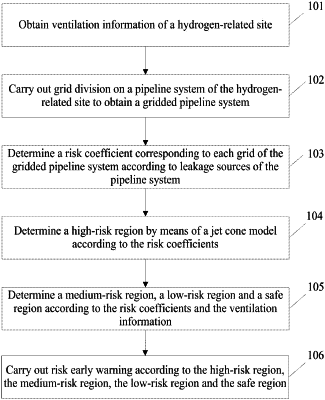| CPC B60L 3/04 (2013.01) | 3 Claims |

|
1. A risk early warning method for hydrogen leakage, comprising:
obtaining ventilation information of a hydrogen-related area;
carrying out grid division on a pipeline system of the hydrogen-related area to obtain a gridded pipeline system;
determining a risk coefficient corresponding to each grid of the gridded pipeline system according to leakage sources of the pipeline system;
determining a high-risk region by means of a jet cone model according to the risk coefficients; wherein the determining the high-risk region by means of the jet cone model according to the risk coefficients comprises:
determining hydrogen concentration distribution by means of the jet cone model according to the risk coefficients; and
determining the high-risk region according to the hydrogen concentration distribution and the leakage sources; wherein
an empirical formula for determining the hydrogen concentration distribution by means of the jet cone model is
 wherein k is a percentage concentration of hydrogen at a certain point in a space, P is a risk coefficient of a grid, z is a longitudinal distance from a leakage opening, r is a radial distance from the leakage opening, uz is a longitudinal velocity of a jet flow, and K is a risk concentration threshold of hydrogen;
determining a medium-risk region, a low-risk region and a safe region according to the risk coefficients and the ventilation information; wherein the determining the medium-risk region, the low-risk region and the safe region according to the risk coefficients and the ventilation information comprises:
determining whether a top ventilation quantity in the ventilation information is greater than a gas volume of the high-risk region to obtain a first determination result;
determining, under the condition that the first determination result is yes, a region of the hydrogen-related area other than the high-risk region as the safe region;
determining, under the condition that the first determination result is no, the medium-risk region according to the risk coefficient and the ventilation information; and
determining the low-risk region and the safe region according to the medium-risk region, the high-risk region, an internal gas volume of the hydrogen-related area and the ventilation information; wherein the determining the low-risk region and the safe region according to the medium-risk region, the high-risk region, an internal gas volume of the hydrogen-related area and the ventilation information comprises:
determining whether the top ventilation quantity and a non-top ventilation quantity synchronously exist in the ventilation information to obtain a second determination result;
determining, under the condition that the second determination result is no, a region of the hydrogen-related area other than the high-risk region and the medium-risk region as the low-risk region; and
determining, under the condition that the second determination result is yes, the low-risk region and the safe region according to the internal gas volume of the hydrogen-related area and the ventilation information; and
carrying out risk early warning according to the high-risk region, the medium-risk region, the low-risk region and the safe region.
|